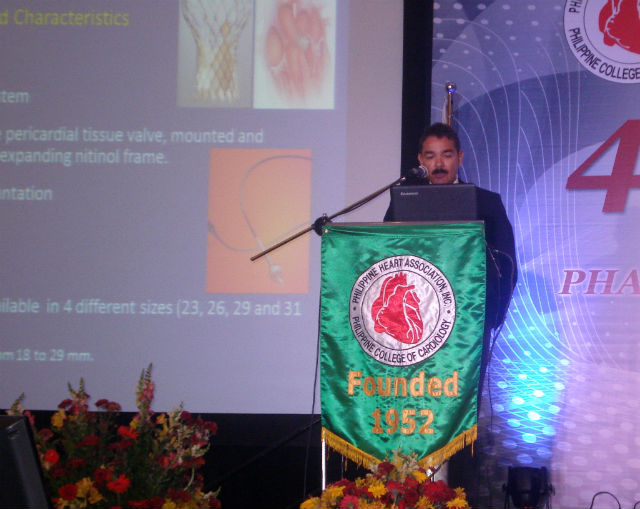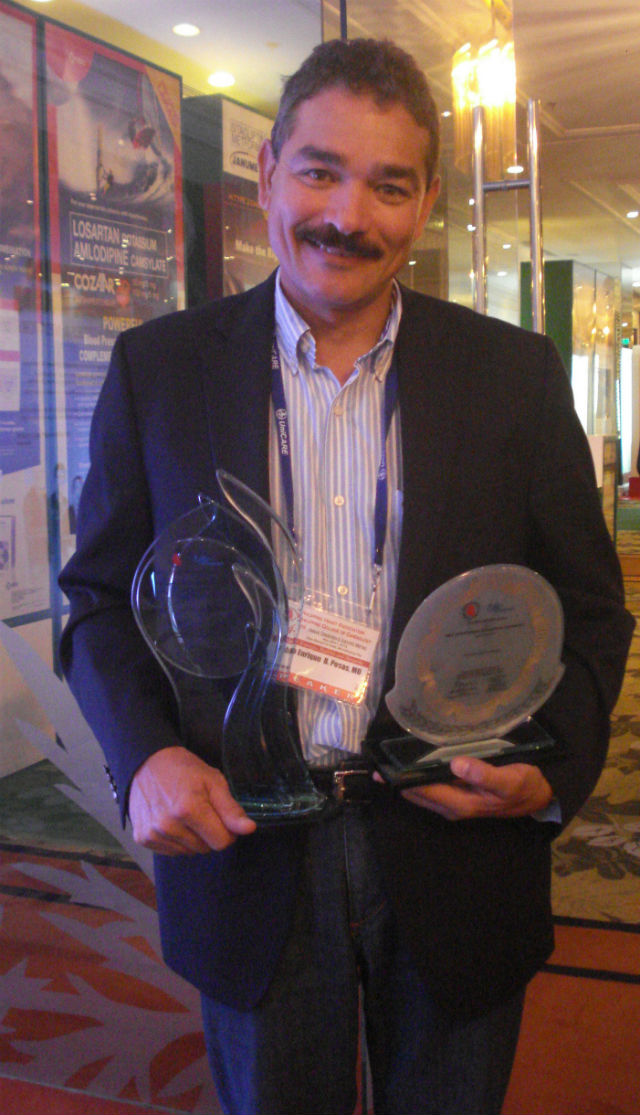Filtered by: Cbb
Community Bulletin Board
St. Luke’s makes strides in life-saving TAVR heart procedure
Patients diagnosed with aortic stenosis with severely narrowed or hardened aortic valves and who experience symptoms such as fainting, chest pains, shortness of breath, fatigue and heart failure, can take comfort in a revolutionary, life-saving heart treatment called Transcatheter Aortic Valve Replacement (TAVR).
TAVR can effectively treat their condition without requiring the rigors of open heart surgery.It was introduced in the Philippines in February 2012 by St. Luke’s Medical Center - Global City’s TAVR Team led by highly experienced interventional cardiologist Dr. Fabio Enrique B. Posas and leading cardiothoracic surgeon Dr. Estanislao de Castro.

Dr. Fabio Enrique B. Posas presents the SLMC and National TAVR Registry to the members of the Philippine Heart Association and Philippine College of Cardiology.
The TAVR technique is internationally recognized as an effective, life-saving,innovative treatment method for aortic stenosis – particularly among the elderly, frail, and patients with complex, multiple medical problems who may be considered too high risk for surgery or who may not be able to tolerate standard open valve replacement.
To date, the St. Luke’s TAVR Team has reinforced its record of performing the most number of TAVRs in the country with 17 successful procedures. Since performing the very first successful TAVR in the Philippines last February 15, 2012, the St. Luke’s TAVR Team continues to have 100 percent success and outcomes comparable to or better than experienced TAVR centers worldwide.
All St. Luke’s patients were successfully implanted with a bioprostheticvalvewhich compares well with the 92.1 percent to 95 percent success rates reported by selected US hospitals and documented by Generaux, Philippe, et. al. in“Clinical Outcomes After Transcatheter Aortic Valve Replacement Using Valve Academic Research Definitions: A Weighted Meta-Analysis of 3,519 Patients from 16 Studies.”

Dr. Fabio Enrique B. Posas receives his awards from the Philippine Heart Association for his outstanding TAVR research papers
Based on a research paper presented by Dr. Posas at the recent Philippine Heart Association (PHA) Annual Convention, St. Luke’s TAVR procedures did not incur any cardiac mortality within 30 days after the procedure.This compares very well with the 7.8 percent mortality of TAVR cases reported at selected US hospitals. He also noted that 82 percent of patients have recovered, have normal valve function, and are already enjoying improved physical capacity and quality of life on follow-up check-ups.
Alongside Dr. Posas in the St. Luke’s TAVR Team is Dr. Estanislao de Castro, a leading cardiothoracic surgeon. The Team also includes leading Filipino cardiac anesthesiologists, cardiac imaging specialists, critical care team and well-trained catheterization laboratory personnel as well as critical care nurses. The St. Luke's team expects to complete its 20th procedure this 2nd half of 2013.
St. Luke’s TAVR Team’s efforts have been recognized during the PHA Servier Most Outstanding Research Awards for their pioneering work on TAVR at the 44th Annual Convention and Scientific Meeting. This accolade is testament to the Team’s proficiency, and accomplishments in pioneering and leading TAVR techniques in the Philippines. It is further proof of St. Luke’s continuous efforts to harness new technologies and techniques designed to provide effective solutions to patients with complex and often life threatening health problems. In South East Asia, St. Luke’s joins a handful of hospitals in Hong Kong, Malaysia, Singapore and Thailand that offers TAVR.
"By harnessing new technologies and making them accessible to people who need them, we not only expand our ability to treat patients but also extend their lives and enhance their quality of life,” said Dr. Posas.
Aortic stenosis is a life threatening and functionally limiting heart disease that increases in prevalence as a person ages. It is commonly a result of severe valve calcification and degeneration which causes the aortic valve to narrow.This obstructs blood flow from the heart and eventually leads to heart failure, functional limitations and, ultimately, death.
The symptoms of aortic stenosis include fainting spells, chest pains or angina, shortness of breath, fatigue and eventually heart failure. Recognizing these symptoms is extremely important given that once patients with aortic stenosis become symptomatic, their mortality increases significantly. Studies show that 50 percent of patients with aortic stenosis and heart failure will die within two years. Furthermore, taking medicines alone have not been shown to decrease mortality or lead to significant improvement in symptoms.
Although open heart surgery is still considered the gold standard for the management of severe, symptomatic aortic stenosis, it requires complex surgical techniques, the use of heart lung machines and it is often associated with prolonged recovery, longer hospital stay and significant risk of mortality and complications. Unlike open heart surgery, TAVR replaces diseased and severely narrowed aortic valves with a new bioprosthetic valve which is deployed using a catheter inserted most often through a patient’s groin arteries. In some patients, it can even be performed under sedation and without surgical cuts. The procedure can be completed in about one and a half hours and allows for a shorter, less painful, less stressful and more rapid recovery time.
Studies comparing open heart valve replacement with TAVR have shown that TAVR performs just as well as open heart surgery. Among patients who cannot undergo open heart surgery, TAVR has shown historical survival advantages when compared to patients treated with medicines alone and it is currently considered the standard of care for such patients.
St. Luke’s TAVR Team has worked closely and been mentored by the world-renowned innovators and inventors of the TAVR technique. Through the personal tutelage and supervision of highly-acclaimed principal TAVR operators and structural heart disease specialists, particularly French TAVR inventor Dr. Jean Claude Labourde, and his colleagues Dr. Eberhard Grube and Dr. Lassen Michev,the St. Luke’s TAVR Team easily honed and perfected their TAVR technique from the maestros themselves.
This collaboration and mentoring also ensured optimal outcomes, patient safety and best medical practices. The St. Luke’s TAVR Team continues to push the envelope in order to provide much-needed medical technological advancements for the benefit of Filipinos. It is also a testament to the team’s mindset that it is their job to find new solutions to solve patients’ problems while minimizing their risks.
This collaboration and mentoring also ensured optimal outcomes, patient safety and best medical practices. The St. Luke’s TAVR Team continues to push the envelope in order to provide much-needed medical technological advancements for the benefit of Filipinos. It is also a testament to the team’s mindset that it is their job to find new solutions to solve patients’ problems while minimizing their risks.
For inquiries on how a Transcatheter Aortic Valve Replacement (TAVR) can help you or a loved one, please call St. Luke’s Medical Center – Global City’s Cardiac Catheterization Laboratory at (02) 7897700 ext. 3025.
Press release and photos from St. Luke’s Medical Center
Press release and photos from St. Luke’s Medical Center
Tags: heartdisease
Find out your candidates' profile
Find the latest news
Find out individual candidate platforms
Choose your candidates and print out your selection.
Voter Demographics
More Videos
Most Popular





